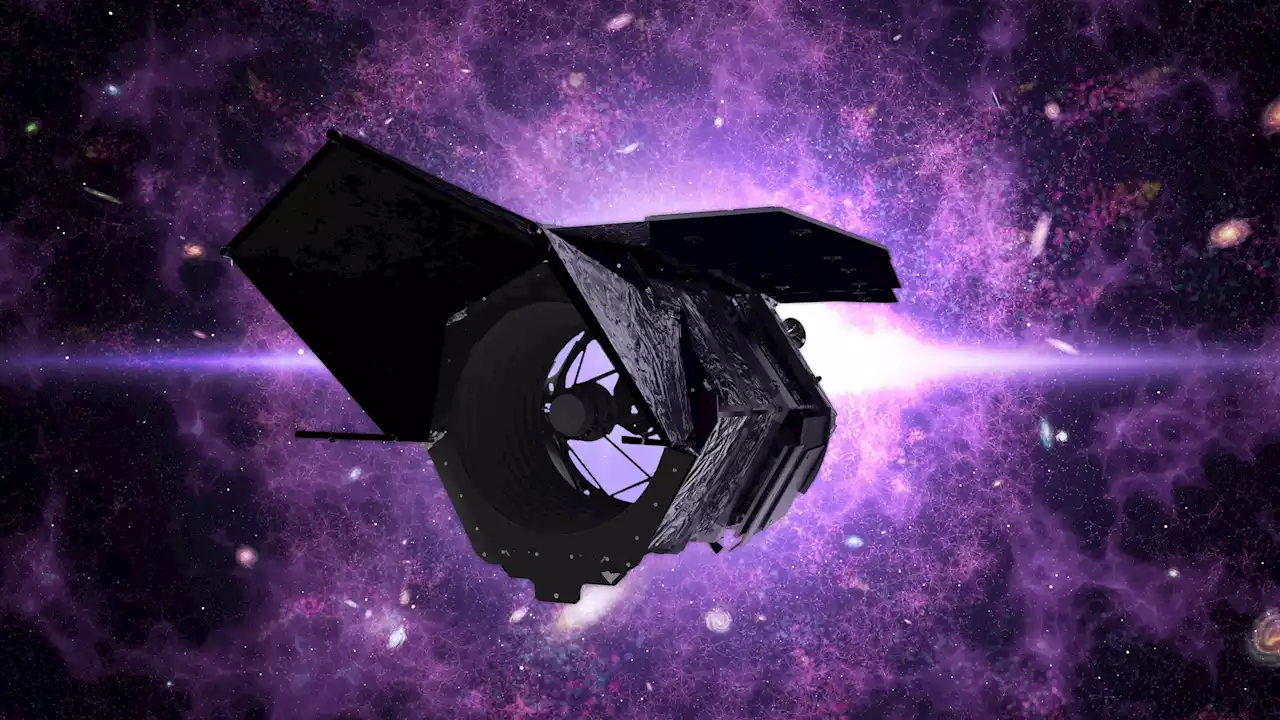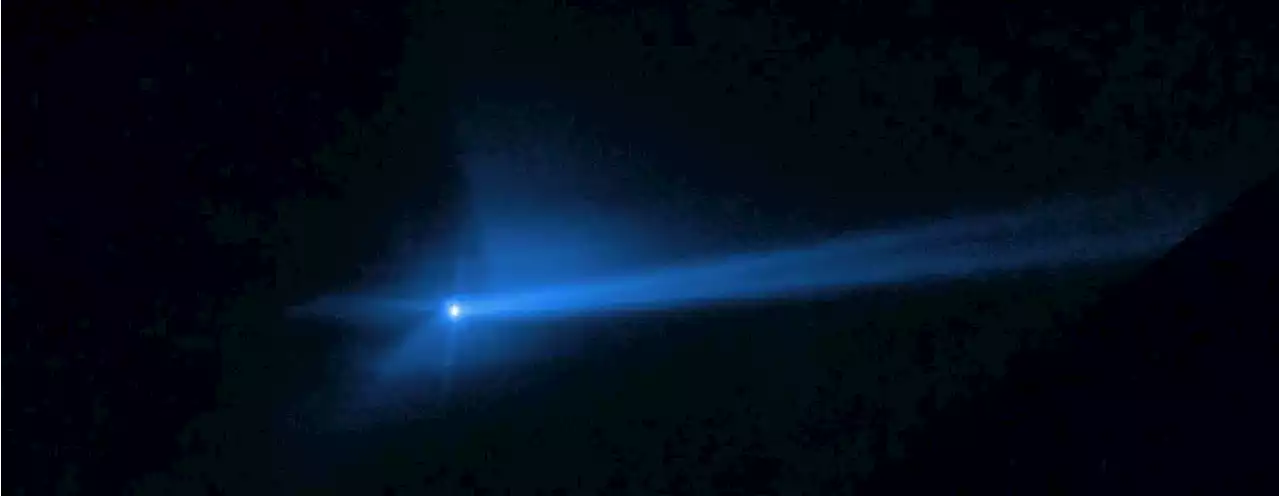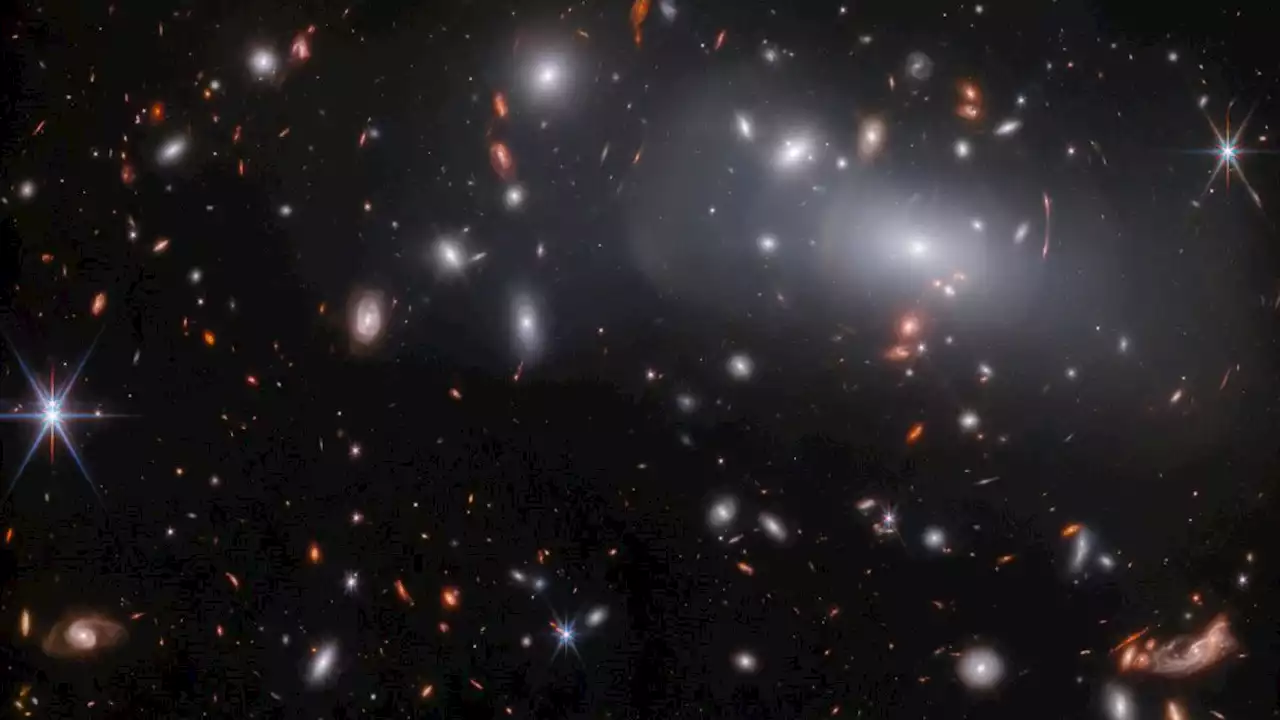Using gravitational lensing and a massive galaxy cluster located 3.2 billion light years away the powerful space telescope replicated a distant galaxy three times in a single image.
, Einstein predicted that mass warps the very fabric of space and time, or"spacetime." This is analogous to placing a ball on a stretched rubber sheet, with the ball causing a dent in the sheet. The greater the mass of the ball the larger the degree of warping it causes. This is also true in the case of spacetime, stars cause a greater"warp" than planets, and galaxies cause a greater warping of space than stars.
This warping affects the passage of light as it travels past the object of mass from a background object. In extreme cases, because light can take different paths around the lensing object from the background lensed object on its way to us, it can cause the background object to be magnified or even appear at multiple points in the sky. That means this phenomenon,"gravitational lensing" has become a powerful tool for astronomers in studying very distant objects.
The lensing object in this new JWST image is the galactic cluster RX J2129, located around 3.2 billion light-years away in thesupernova explosion was discovered by astronomers using the Hubble Space Telescope and is a Type Ia supernova designated AT 2022riv. These are often referred to as"standard candles" by astronomers because of how uniform their light is. This uniformity means that Type Ia supernovas can actually be used as a tool of measure cosmic distances because at the same distance, they would look exactly the same.
As a gravitational lens, RX J2129 has created three images of this galaxy that aren't the same in size, position, or even age because of the different paths the light from the backgroundThe unannotated image from the James Webb Space Telescope showing a large elliptical galaxy surrounded by many smaller similar galaxies, including the galaxy cluster RX J2129 and upper right.
Brasil Últimas Notícias, Brasil Manchetes
Similar News:Você também pode ler notícias semelhantes a esta que coletamos de outras fontes de notícias.
 7 things you didn’t know about the James Webb Space TelescopeThink you know everything about the James Webb Space Telescope? Think again. Here are seven secrets you might not know about Webb.
7 things you didn’t know about the James Webb Space TelescopeThink you know everything about the James Webb Space Telescope? Think again. Here are seven secrets you might not know about Webb.
Consulte Mais informação »
 Webb telescope captures galaxy three times: Why it happenedThe James Webb Space Telescope captured an image that shows the same galaxy three times due to gravitational lensing from a galaxy cluster that is 3.2 billion light-years from Earth.
Webb telescope captures galaxy three times: Why it happenedThe James Webb Space Telescope captured an image that shows the same galaxy three times due to gravitational lensing from a galaxy cluster that is 3.2 billion light-years from Earth.
Consulte Mais informação »
 NASA’s Roman Space Telescope Will Unveil Echoes of the Universe’s CreationNASA’s Nancy Grace Roman Space Telescope will detect vestiges of sound waves that once rippled through the primordial cosmic sea. According to new simulations, Roman’s observations could extend these measurements into an unprobed epoch between the universe’s infancy and the present day. Studying the
NASA’s Roman Space Telescope Will Unveil Echoes of the Universe’s CreationNASA’s Nancy Grace Roman Space Telescope will detect vestiges of sound waves that once rippled through the primordial cosmic sea. According to new simulations, Roman’s observations could extend these measurements into an unprobed epoch between the universe’s infancy and the present day. Studying the
Consulte Mais informação »
 Turning Back the Cosmic Clock: How NASA’s Roman Space Telescope Will Rewind the UniverseA new simulation shows how NASA’s Nancy Grace Roman Space Telescope will turn back the cosmic clock, unveiling the evolving universe in ways that have never been possible before when it launches by May 2027. With its ability to rapidly image enormous swaths of space, Roman will help us understand ho
Turning Back the Cosmic Clock: How NASA’s Roman Space Telescope Will Rewind the UniverseA new simulation shows how NASA’s Nancy Grace Roman Space Telescope will turn back the cosmic clock, unveiling the evolving universe in ways that have never been possible before when it launches by May 2027. With its ability to rapidly image enormous swaths of space, Roman will help us understand ho
Consulte Mais informação »
 Hubble Space Telescope Captures Movie of DART Asteroid Impact DebrisThis movie captures the breakup of the asteroid Dimorphos when it was deliberately hit by NASA’s 545-kilogram Double Asteroid Redirection Test (DART) mission spacecraft on 26 September 2022. The NASA/ESA Hubble Space Telescope had a ringside view of the space demolition derby. The Hubble movie st
Hubble Space Telescope Captures Movie of DART Asteroid Impact DebrisThis movie captures the breakup of the asteroid Dimorphos when it was deliberately hit by NASA’s 545-kilogram Double Asteroid Redirection Test (DART) mission spacecraft on 26 September 2022. The NASA/ESA Hubble Space Telescope had a ringside view of the space demolition derby. The Hubble movie st
Consulte Mais informação »
 Hubble Space Telescope captures a jellyfish galaxy | Digital TrendsThis Hubble image shows a jellyfish galaxy, a galaxy type named for its larger main body with tendrils that float along after it like the sea creature.
Hubble Space Telescope captures a jellyfish galaxy | Digital TrendsThis Hubble image shows a jellyfish galaxy, a galaxy type named for its larger main body with tendrils that float along after it like the sea creature.
Consulte Mais informação »
